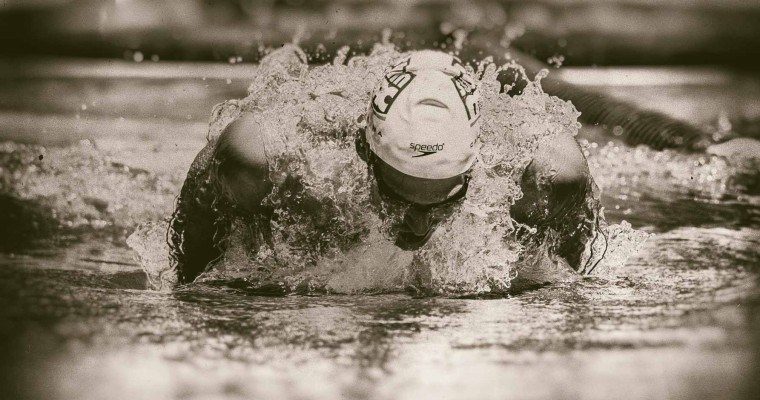Training is at the top of your priority, and your recovery is essential to getting through the next few weeks of high intensity workouts. For the 19-20 hours in the day that you spend off the pool deck, you have complete control over your recovery and how well you treat your body. Let’s take a look at five specific changes you can make to your daily routine that will help you recover faster!
1. Sleep More
Being disciplined about your bedtime can make a huge impact on your training. Instead of going through the motions in morning practices, you can wake up feeling more restored from the previous day’s training and ready to hit the ground running. Go to bed one hour earlier than you usually do. See how you feel. Sleep is a key time for the body to undergo protein synthesis so catch some more shut-eye and let your body develop muscle tissue while you’re at it.
2. Eat Protein Pre- and Post-Workout
Swimmers need a combination of protein and carbs to get through lengthy preseason workouts. Consuming protein before workout can supply the necessary amino acids to stimulate muscle protein synthesis in the muscles that will be engaged during resistance training1. This proteins synthesis can carry on long after workout has ended if the athlete chooses to refuel properly with more protein after practice. Always remember to balance your protein intake with other necessary nutrients. Your main form of energy is carbohydrate, so try to have both pre- and post-workout.
3. Try Compression Garments
Some athletes opt for compression pants to help accelerate the recovery process. Recent research shows that these tight garments can accelerate lactate clearance from the muscle tissue and reduce heart rate following high-intensity exercise2. These garments can be handy during competition season as well, when quick recovery between morning and evening sessions of a meet is critical.
4. Get on the Foam Roller
Your muscles may feel exceptionally tight the day after a strength training session in preseason. You may not have lifted in awhile, and therefore may feel more broken down. A lot of this tightness can be attributed to tangled muscle and fascia tissue. Rolling out on a foam roller can apply pressure to knotted areas and help release the muscle from the layer of fascia, thereby boosting circulation and helping you get your range of motion back.
5. Try a Power Nap
Research suggests that taking a quick 10-20 minute nap can leave you feeling more energized and alert than a nap lasting 1-2 hours3. Between morning and afternoon practice, find 20 minutes to close your eyes. You’ll be able to find an extra gear during afternoon practice and feel an improvement in your mood as well. Remember to set an alarm!
References:
1. Am J Physiol Endocrinol Metab. 2001 Aug;281(2):E197-206.
Timing of amino acid-carbohydrate ingestion alters anabolic response of muscle to resistance exercise. Tipton KD1, Rasmussen BB, Miller SL, Wolf SE, Owens-Stovall SK, Petrini BE, Wolfe RR.
2. J Strength Cond Res. 2011 Dec;25(12):3264-8. doi: 10.1519/JSC.0b013e31821764f8.
Do compression garments enhance the active recovery process after high-intensity running? Lovell DI1, Mason DG, Delphinus EM, McLellan CP.
3. Curr Opin Pulm Med. 2006 Nov;12(6):379-82.
Good sleep, bad sleep! The role of daytime naps in healthy adults.
ABOUT BRIDGEATHLETIC
 BridgeAthletic works with elite professional, collegiate, and club swimming programs to provide a turnkey solution for dryland training. Led by Nick Folker, the top swimming strength and conditioning coach in the world, our team builds stroke-specific, custom-optimized dryland programs for each of our clients. The individualized workouts are delivered directly to athletes via our state of the art technology platform and mobile applications. Check Nick and BridgeAthletic out as recently featured in SwimSwam.
BridgeAthletic works with elite professional, collegiate, and club swimming programs to provide a turnkey solution for dryland training. Led by Nick Folker, the top swimming strength and conditioning coach in the world, our team builds stroke-specific, custom-optimized dryland programs for each of our clients. The individualized workouts are delivered directly to athletes via our state of the art technology platform and mobile applications. Check Nick and BridgeAthletic out as recently featured in SwimSwam.
ABOUT NICK FOLKER
 Nick Folker is the Co-Founder and Director of Elite Performance at BridgeAthletic. Nick’s roster of athletes includes 35 Olympians winning 22 Olympic Medals, 7 team NCAA Championships and over 170 individual and relay NCAA championships. Megan Fischer-Colbrie works as the Sports Science Editor at BridgeAthletic. Megan was a four-year varsity swimmer at Stanford, where she recently graduated with a degree in Human Biology. The Championship Series by BridgeAthletic is designed to empower athletes with tips from the pros that will help them reach peak performance come race day. We will be covering competition-focused topics such as nutrition, recovery, stretching, and mental preparation.
Nick Folker is the Co-Founder and Director of Elite Performance at BridgeAthletic. Nick’s roster of athletes includes 35 Olympians winning 22 Olympic Medals, 7 team NCAA Championships and over 170 individual and relay NCAA championships. Megan Fischer-Colbrie works as the Sports Science Editor at BridgeAthletic. Megan was a four-year varsity swimmer at Stanford, where she recently graduated with a degree in Human Biology. The Championship Series by BridgeAthletic is designed to empower athletes with tips from the pros that will help them reach peak performance come race day. We will be covering competition-focused topics such as nutrition, recovery, stretching, and mental preparation.
Follow BridgeAthletic on Twitter here.
Like BridgeAthletic on Facebook here.
Swimming News / Swim Training courtesy of BridgeAthletic, a SwimSwam partner.


Is this for members only?
While a 20 minute nap may leave you feeling more alert and refreshed a 1.5 hour nap will maximize your anabolic response. While napping for that long is usually unrealistic for anyone who isn’t a professional athlete, high school and college swimmers on winter break do have that kind of time, and since they are also in the midst of their heaviest training, they should consider log naps unless it takes away from their sleep at night.